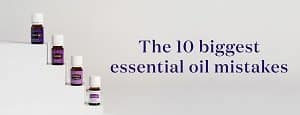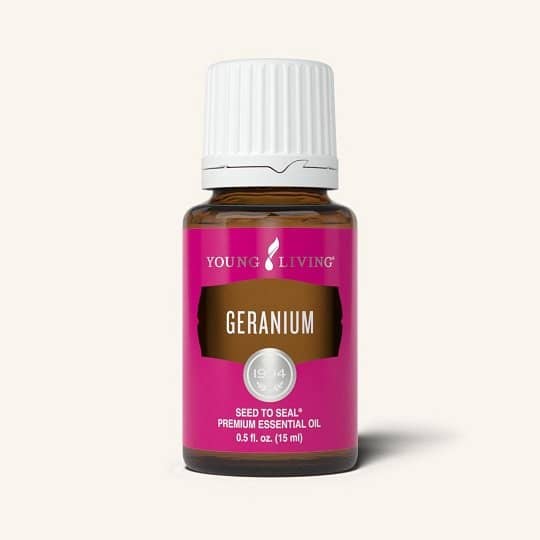Geranium Essential Oil
Pelargonium graveolens
Geranium essential oil is commonly used in perfumes for its uplifting aroma, and it may reduce the appearance of blemishes and fine lines when applied topically.* It is steam distilled from the flowers, leaves, and stems of the Pelargonium graveolens plant, a multibranched shrub that grows up to 5 feet tall. Native to subtropical southern Africa, geranium was used traditionally by the Egyptians to promote beautiful, radiant skin. Today Geranium essential oil is obtained from Africa and Madagascar and is used in many perfumes and cosmetics for its fresh, floral aroma and skin care benefits. In addition to use in topical products and perfumes, Geranium essential oil can be diffused or inhaled for its uplifting and soothing aroma.
Product Profile
-
Has a fresh, floral aroma that is uplifting to the senses
-
May help maintain the appearance of healthy, youthful-looking skin
-
Helps promote shiny, lustrous hair
-
Provides skin-cleansing benefits
Product Use & Tips
Suggestions from Young Living
-
Topical: Dilute 1 drop with 1 drop of V-6™ Vegetable Oil Complex and apply to the desired area as needed.
-
Aromatic: Diffuse up to 1 hour 3 times daily.
-
Diffuse Geranium with Grapefruit or Tangerine for a bright, uplifting aroma.
-
Add a few drops to your facial essence, serum, or moisturizer to help promote the appearance of healthy, youthful skin.
-
Apply it to your hair to promote shine and wear it as a hair perfume.
-
Combine it with oils like Lavender and Ylang Ylang in a hot bath to create a peaceful, private getaway.
Related to this Product

10 Biggest Essential Oil Mistakes

10 Essential Oil Tips for Your Bedtime Routine

10 Things Essential Oil Users Do Differently

20 Essential Oils Practically Made for Summer

21 Ways to Reuse Empty Essential Oil Bottles

36 Ways to Use a Bottle of Essential Oil

6 Essential Oils Your Skin Loves

7 Essential Oils to Try Before You Lose Your Chill

8 Neroli Self-care Tips You’ve Got to Try

A Guide to Geranium Essential Oil
DIY Exfoliating Soap
Dry, itchy skin got you down? Don’t worry, there’s hope—or rather, soap—for that! With our all-natural, homemade exfoliating soaps, hydrated skin is only a shower away.
Gentle exfoliation is the key to silky-soft skin. Our DIY soap bars include natural exfoliating ingredients to remove dead skin from the surface, plus a combination of coconut and essential oils to soothe as you scrub.
After a couple weeks, don’t be surprised if your friends are all, “Look at you glow, girl!” the next time you meet for lunch.
Ingredients:
Base:
• 6 ounces suspended organic melt and pour glycerin soap
• 1 tablespoon coconut oil
Mix-ins:
• Exfoliating ingredient
• Essential oils
Directions:
1. Cut soap into about 1-inch cubes.
2. Put soap and coconut oil in a large microwave-safe bowl.
3. Microwave for 30 seconds at a time until soap is completely melted, stirring in between to smooth clumps.
4. Add essential oils and mix well.
5. Add exfoliating ingredient slowly, stirring well to combine and remove all clumps. Work quickly before the soap gets too cool.
6. Pour into molds. Let sit until solid, approximately 1-3 hours.
Rosemary-Lemon-Sage soap with cornmeal
Mix-ins:
• 1 tablespoon cornmeal
• 10 drops Lemon essential oil
• 10 drops Rosemary essential oil
• 10 drops Sage essential oil
Cinnamon-Orange-Ginger soap with coffee grounds
Mix-ins:
• 2 tablespoon organic coffee grounds
• 15 drops Cinnamon Bark essential oil
• 10 drops Ginger essential oil
• 10 drops Orange essential oil
Joy-Geranium-Patchouli soap with poppy seeds and pink Himalayan salt
Mix-ins:
• 1 teaspoon poppy seeds
• 1-2 tablespoons fine pink Himalayan salt
• 15 drops Joy essential oil blend
• 10 drops Patchouli essential oil
• 10 drops Geranium essential oil
Diffusing Notes
These are approximate drops. Adjust recipes to your needs. If a recipe is too strong for you, add fewer drops. Do you need more? Just add more, but no more than 8-12 drops for all of our diffusers with the exception of the Aria diffuser which requires 15-25 drops.
Tip: When you first begin diffusing, start with less essential oil than listed in the recipes and build to more as desired. You should give your body time to adjust to the essential oils. Almost all the Young Living diffusers are ultrasonic which provides a cool-mist humidifier along with the essential oils. These diffusers are safe to run all day. Pay attention to the size of the room because the size will impact the intensity of diffusing. Nebulizers and atomizers are different than ultrasonic diffusers because they do not use water. For these, note the time limit for diffusing stated on each individual oil bottle.
Ultrasonic Diffusers
Ultrasonic diffusers work by using vibrations to break down water and essential oils into tiny particles, creating a fine mist that is released into the air. Inside the diffuser, there’s a small disc that vibrates rapidly, usually at ultrasonic frequencies (beyond what humans can hear). This vibration agitates the water and oil mixture, breaking it into micro-droplets that are then dispersed as a mist. This mist carries the pleasant aroma of the essential oils and tiny water particles, helping to humidify the air and spread the fragrance throughout a room. Ultrasonic diffusers are popular for their ease of use, quiet operation, and ability to provide both aromatherapy benefits and a visually appealing ambiance.
Cleaning Your Diffuser
- Always turn off and unplug the diffuser prior to cleaning.
- To ensure proper performance, clean the ultrasonic plate and lid after each use.
- If essential oil begins to build up on the ultrasonic plate, gently wipe it off using a cotton swab dipped in rubbing alcohol.
- If essential oil begins to build up on the lid, gently wipe it off using mild soap and water only.
- Never use a corrosive detergent to clean the ultrasonic plate or damage will occur.
- Periodically check under the diffuser to keep the fan intake free of debris.
- Debris can be removed by blowing on the fan intake opening or wiping with a clean, dry cloth. (Do not use aerosol sprays, solvents, or abrasives to clean the plastic housing.)
- When not in use, clean the diffuser and store dry. Replacement ultrasonic plates can be purchased from Young Living.
Aromatherapy
When odorant molecules attach to odorant receptors, your body responds by sending electrical impulses into your brain. This causes different physiological reactions depending on the aromas detected.
The sense of smell has a profound impact on your emotions and inner desires. Those scents can set the mood or bring up memories before you are even aware of it.
Aromas impact your body and they can set the mood and atmosphere in any environment.
The sense of smell is directly connected to the limbic lobe of your brain, also known as the emotional control center. The limbic lobe plays a big role in your mood, memory, behavior, feelings, and emotions, and it is connected to the olfactory bulb in the nose.
How to Use Essential Oils
Aromatically, Topically, Internally & Safely
You just purchased a bundle, kit, or collection of essential oils. Now you’re overwhelmed by how to use them. We’ve all been intimidated by how to use essential oils. With a little practice and this simple guide, you’ll be an expert in no time.
This video covers how to use essential oils:
• Aromatically
• Topically
• Internally
• Safely
How to Apply Essential Oils - Three Main Methods
Stumped on how to apply your essential oils? How you apply an oil depends on what benefit you want to get out of it. Different oils offer different benefits, depending on how and where you apply them. So, before using any new essential oil, be sure to check that oil’s uses and benefits and read any labels and instructions that come with it. If you have questions or concerns, check with your healthcare provider.
Using Essential Oils Aromatically
Let’s start with the hallmark way to use essential oils: aromatically. All essential oils feature a signature aroma you can smell and inhale for various effects. One oil’s crisp scent can invigorate you when you need a midday pick-me-up. Another’s soothing aroma can help you unwind after a tough day. You can use essential oils aromatically by simply opening the bottle and inhaling its aroma. They can also be applied topically as a personal fragrance, but always dilute them with a carrier oil, which is a plant-derived oil like coconut or almond oil. Dilute a few drops of essential oil with your carrier oil and then rub it into your palms and inhale or dab some behind your ear or on your neck. You can also use a diffuser to disperse the essential oil into the air.
Using Essential Oils Topically
Another favourite way to apply essential oils is topically, where you allow the oil to absorb into your skin. As mentioned before, always dilute oils with a carrier oil before you apply them topically. Topical oils can become part of a massage or added to your preferred lotion, moisturizer or other personal care product. Some oils, particularly those from the citrus family, can cause photosensitivity. A carrier oil is a plant-derived oil like coconut and almond oil that can be used to dilute an essential oil’s concentration.
Using Essential Oils Internally
If you think an oil smells terrific, wait until you taste it! You can season your favourite dish or flavor a drink with certain grades of essential oils. Ingesting oils lets you savor all their savory, herbaceous, spicy, fruity potential. The simplest ways to take essential oils internally is to add them to a glass of water, take them in a capsule or use them as seasoning. Start off with a small amount. A little goes a long way, and even a single drop might overpower your recipe. One recommendation is to dip a toothpick in the oil and stir that little bit in as a starting point. Of course, before you use any oils internally, make sure the oil is safe to ingest. Unless it specifically says on the label that it’s safe for ingestion, assume it’s safe for external use only.
Diffusing Blends with These Oils
Related Areas

Can essential oils expire? Understanding essential oil oxidation

Why Patents Matter to Essential Oils

How to Store Essential Oils: Get the Most Out of Each Drop

What are “hot” Oils and How Can I Use Them?

Why Should You Put Essential Oils on Your Feet?

The Science Behind Aromatherapy

Which Type of Diffuser is Right for You?

The Story Behind Essential Oil Prices
* The statements and information regarding these products have not been evaluated by the FDA. Young Living products are not intended to diagnose, treat, cure, or prevent disease. Most of the product information describing Young Living products is directly from Young Living Essential Oils, LC, and can be found online at YoungLiving.com
See more about toxins in your home.









